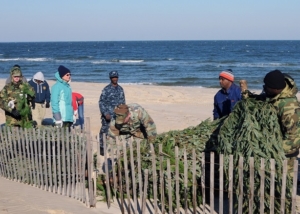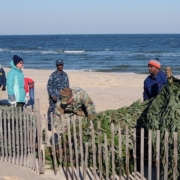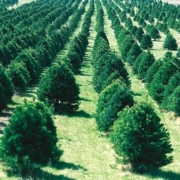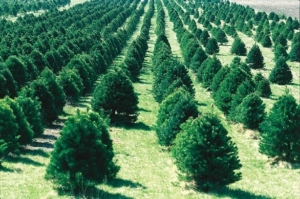4 Ways to Recycle Your Christmas Tree
4 Ways to Recycle Your Christmas Tree
Real Christmas trees are sustainably produced on farms in North America and they are 100% recyclable. Because they are 100% natural and biodegradable, there are many different ways to recycle your real Christmas tree once the holiday season has ended. Many towns offer local pickup services that will grind or chip the tree into mulch, compost, or biomass. However, in some regions of North America, there are special programs that use Christmas trees to have other positive impacts on the environment.
Rebuilding the Louisiana Coastline

Sailors assigned to Construction Battalion Maintenance Unit 202 and civilians with the Environmental Division at Joint Expeditionary Base Little Creek-Fort Story, place recycled Christmas trees at “E” Beach at Joint Expeditionary Base Little Creek-Fort Story. The recycled trees are used to preserve sand dunes and prevent erosion. (Photo by Seaman Tamekia Perdue)
It’s estimated that the state of Louisiana loses between 25 and 35 square miles of coastal wetlands per year. Since 1986, 1.5 million Christmas trees have been recycled on the Louisiana coastline of Jefferson Parish. The trees are stacked to assemble a fence-like structure to combat erosion and slow wave action. This tree recycling program is estimated to have restored between 250 and 300 acres of marshland. There are currently about 8 miles worth of Christmas tree fences in this program.
Sand Dune Restoration
In recent years, devastating hurricanes on the east coast washed away protective sand dunes. For coastal towns, sand dunes are frequently the first line of defense against storms. The dunes protect backyards and basements from rising ocean waters. Some localities are using Christmas trees to help restore the sand dunes.
The Christmas trees are laid horizontally on the beach in piles, which forces sand to accumulate around them, so grass can grow. Over time, this will ultimately restore the sand dunes that were washed away during the storm and the trees will naturally decompose through biodegradation.
Bird Sanctuaries
In Illinois, herons and egrets have been forced from their native habitat by development. In 2000, a manmade rookery was built at Baker’s Lake Forest Preserve just outside of Chicago, offering native birds a place to nest. About 300-400 recycled Christmas trees are added to it each winter. The rookery is a tall, vertical structure on a small island at the lake. The Christmas trees hang from the rookery to provide shelter and privacy.
Pickup
Across North America, the Boy Scouts have partnered with local communities to host Christmas tree recycling programs. Programs like these are frequently used as fundraisers to support local chapters to pick up your tree in exchange for a small donation. However, many cities offer free pickup as well. Most often trees picked up in this manner are grinded into wood chips, biomass, or made into compost.
Remember to remove all decorations, lights, ornaments, and tinsels from the tree before donating it. For additional tree pickup services in the United States, consider using this handy recycling search tool by Earth911 listed at the bottom of this page.
Resources
- Local Recycling Programs via Earth911
- On Decimated Shore, a Second Life for Christmas Trees
- Baker’s Lake Forest Preserve
- Coming Home to Nest
- Rebuilding the Louisiana Coastline in Jefferson Parish, Louisiana
(Above photograph by Wikimedia, distributed under a CC-BY 2.0 license)







